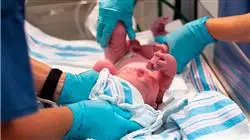University certificate
The world's largest faculty of nursing”
Introduction to the Program
Understand and develop your skills in the approach and management of the complications of hematopoietic progenitor transplant patients in the short, medium and long term"

Hematopoietic Progenitor Transplantation has been used as a treatment in several hematological and oncological diseases, being reserved for those patients who have no other treatment possibility. This is not to say that it is a process that is exempt from risk or the development of a stressful situation in pediatric patients. Therefore, the support of the family and the professionals must be counted on so that the children feel secure in this process.
Thus, the Postgraduate diploma in Allogeneic HSCT in Pediatrics for Nursing will provide students with all the necessary and updated information in this field. It will begin by providing the student with the knowledge and skills necessary for the recognition, management and initial stabilization of pediatric hematological patients who suffer a vital compromise derived from a complication of their underlying disease, an intercurrent process or undesired consequences of their treatment, in an effective, safe and coordinated manner, and integrating their interventions with the rest of the health system services at the hospital level.
In the following modules, you will have a broader view of the process used to identify pediatric patients with hematologic pathology who are candidates for allogeneic hematopoietic stem cell transplantation. In this way, students will acquire the necessary skills to ensure comprehensive patient care during all stages of this procedure.
By the end of the program, the professional will have developed a set of knowledge and skills for the comprehensive approach and management of children and adolescents with severe hematologic pathology and their families. All this, taking into account the facilitating and emotional role of nurses in the field of pediatric hematology.
The teaching team assembled for this Postgraduate diploma is of recognized prestige and has extensive experience in national and international reference units in the treatment and care of newborns, children and adolescents with hematological disease. The program is 100% online, making it easy for the student to take it comfortably, wherever and whenever they want. All you need is a device with internet access to take your career one step further. A modality according to the current times with all the guarantees to position the nurse in a highly demanded sector.
Understand the importance of therapeutic communication in the care of children and adolescents with severe hematologic pathology and their Family”
This Postgraduate diploma in Allogeneic HSCT in Pediatrics for Nursing contains the most complete and up-to-date scientific program on the market.¡ The most important features include:
- The development of case studies presented by experts in Pediatric Hematology for Nurses
- The graphic, schematic, and eminently practical contents with which they are created, provide scientific and practical information on the disciplines that are essential for professional practice
- Practical exercises where self-assessment can be used to improve learning.
- Its special emphasis on innovative methodologies
- Theoretical lessons, questions to the expert, debate forums on controversial topics, and individual reflection assignments
- Content that is accessible from any fixed or portable device with an Internet connection
Attain sufficient knowledge and skills to be able to develop the personal and professional attitudes necessary to welcome children and adolescents and their families who are going to undergo allo-HPT”
The program’s teaching staff includes professionals from the sector who contribute their work experience to this training program, as well as renowned specialists from leading societies and prestigious universities.
The multimedia content, developed with the latest educational technology, will provide the professional with situated and contextual learning, i.e., a simulated environment that will provide immersive training programmed to train in real situations.
The design of this Program focuses on Problem-Based Learning, by means of which the professional will have to try to solve the different situations of Professional Practice, which will be posed throughout the Program. For this purpose, the student will be assisted by an innovative interactive video system created by renowned and experienced experts.
It carries out a comprehensive care plan for children with incurable diseases and their families, following a program supported by an excellent teaching team"

It covers the most frequent situations in which the child and adolescent with severe hematologic disease requires intensive care"
Why study at TECH?
TECH is the world’s largest online university. With an impressive catalog of more than 14,000 university programs available in 11 languages, it is positioned as a leader in employability, with a 99% job placement rate. In addition, it relies on an enormous faculty of more than 6,000 professors of the highest international renown.

Study at the world's largest online university and guarantee your professional success. The future starts at TECH”
The world’s best online university according to FORBES
The prestigious Forbes magazine, specialized in business and finance, has highlighted TECH as “the world's best online university” This is what they have recently stated in an article in their digital edition in which they echo the success story of this institution, “thanks to the academic offer it provides, the selection of its teaching staff, and an innovative learning method aimed at educating the professionals of the future”
A revolutionary study method, a cutting-edge faculty and a practical focus: the key to TECH's success.
The most complete study plans on the university scene
TECH offers the most complete study plans on the university scene, with syllabuses that cover fundamental concepts and, at the same time, the main scientific advances in their specific scientific areas. In addition, these programs are continuously being updated to guarantee students the academic vanguard and the most in-demand professional skills. In this way, the university's qualifications provide its graduates with a significant advantage to propel their careers to success.
TECH offers the most comprehensive and intensive study plans on the current university scene.
A world-class teaching staff
TECH's teaching staff is made up of more than 6,000 professors with the highest international recognition. Professors, researchers and top executives of multinational companies, including Isaiah Covington, performance coach of the Boston Celtics; Magda Romanska, principal investigator at Harvard MetaLAB; Ignacio Wistumba, chairman of the department of translational molecular pathology at MD Anderson Cancer Center; and D.W. Pine, creative director of TIME magazine, among others.
Internationally renowned experts, specialized in different branches of Health, Technology, Communication and Business, form part of the TECH faculty.
A unique learning method
TECH is the first university to use Relearning in all its programs. It is the best online learning methodology, accredited with international teaching quality certifications, provided by prestigious educational agencies. In addition, this disruptive educational model is complemented with the “Case Method”, thereby setting up a unique online teaching strategy. Innovative teaching resources are also implemented, including detailed videos, infographics and interactive summaries.
TECH combines Relearning and the Case Method in all its university programs to guarantee excellent theoretical and practical learning, studying whenever and wherever you want.
The world's largest online university
TECH is the world’s largest online university. We are the largest educational institution, with the best and widest online educational catalog, one hundred percent online and covering the vast majority of areas of knowledge. We offer a large selection of our own degrees and accredited online undergraduate and postgraduate degrees. In total, more than 14,000 university degrees, in eleven different languages, make us the largest educational largest in the world.
TECH has the world's most extensive catalog of academic and official programs, available in more than 11 languages.
Google Premier Partner
The American technology giant has awarded TECH the Google Google Premier Partner badge. This award, which is only available to 3% of the world's companies, highlights the efficient, flexible and tailored experience that this university provides to students. The recognition as a Google Premier Partner not only accredits the maximum rigor, performance and investment in TECH's digital infrastructures, but also places this university as one of the world's leading technology companies.
Google has positioned TECH in the top 3% of the world's most important technology companies by awarding it its Google Premier Partner badge.
The official online university of the NBA
TECH is the official online university of the NBA. Thanks to our agreement with the biggest league in basketball, we offer our students exclusive university programs, as well as a wide variety of educational resources focused on the business of the league and other areas of the sports industry. Each program is made up of a uniquely designed syllabus and features exceptional guest hosts: professionals with a distinguished sports background who will offer their expertise on the most relevant topics.
TECH has been selected by the NBA, the world's top basketball league, as its official online university.
The top-rated university by its students
Students have positioned TECH as the world's top-rated university on the main review websites, with a highest rating of 4.9 out of 5, obtained from more than 1,000 reviews. These results consolidate TECH as the benchmark university institution at an international level, reflecting the excellence and positive impact of its educational model.” reflecting the excellence and positive impact of its educational model.”
TECH is the world’s top-rated university by its students.
Leaders in employability
TECH has managed to become the leading university in employability. 99% of its students obtain jobs in the academic field they have studied, within one year of completing any of the university's programs. A similar number achieve immediate career enhancement. All this thanks to a study methodology that bases its effectiveness on the acquisition of practical skills, which are absolutely necessary for professional development.
99% of TECH graduates find a job within a year of completing their studies.
Postgraduate Diploma in Allogeneic HCT in Pediatrics for Nursing
Allogeneic Hematopoietic Progenitor Transplantation in Pediatrics is a complex process that requires a multidisciplinary and updated team to ensure the success of the procedure and the recovery of the patient with various hematological diseases. Thus, nurses updated in this area are very necessary for hospital centers to preserve the welfare of the little ones. For this reason, TECH has created the Postgraduate Diploma in Allogeneic HSCT in Pediatrics for Nursing, a program that will guarantee your professional growth in this field in a 100% online way and without having to leave your home.
Learn from the comfort of your own home
Learn the latest techniques to care for the pediatric patient who has undergone Allogeneic Hematopoietic Progenitor Transplantation, as well as strategies to prevent possible complications, thanks to the Postgraduate Diploma in Allogeneic HSCT in Pediatrics for Nursing. Its very complete didactic materials, presented in various multimedia formats, will optimize your teaching and will allow you to adapt your study to your academic needs.







